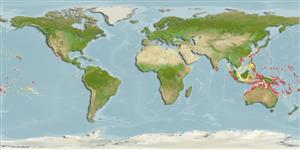>
Blenniiformes (Blennies) >
Blenniidae (Combtooth blennies) > Blenniinae
Etymology: Plagiotremus: Greek, plagios = oblique + Greek, trema = hole (Ref. 45335).
More on author: Whitley.
Environment: milieu / climate zone / depth range / distribution range
Écologie
marin récifal; profondeur 0 - 30 m (Ref. 90102). Tropical; 33°N - 32°S
Western Pacific: Philippines and Ryukyu Islands to the Gilbert Islands, New Caledonia, and Samoa, north to Izu Islands, south to Rowley Shoals and Lord Howe Island; throughout Micronesia. Subspecies Plagiotremus laudandus flavus occurs in Fiji and Tonga.
Taille / Poids / Âge
Maturity: Lm ? range ? - ? cm
Max length : 8.0 cm TL mâle / non sexé; (Ref. 9710)
Description synthétique
Clés d'identification | Morphologie | Morphométrie
Épines dorsales (Total) : 7 - 10; Rayons mous dorsaux (Total) : 27 - 30; Épines anales: 2; Rayons mous anaux: 22 - 24. Color variable, usually grey-blue and posterior part of the body often paler or yellow (Ref. 48636).
Adults are found solitary in coastal, lagoon and seaward reefs from below the surge zone to 30 m depth (Ref. 9710, 90102). They feed on skin, scales, fins and mucus of other fish. Oviparous. Eggs are demersal and adhesive (Ref. 205), and are attached to the substrate via a filamentous, adhesive pad or pedestal (Ref. 94114). Larvae are planktonic, often found in shallow, coastal waters (Ref. 94114). A mimic of Meiacanthus atrodorsalis (Ref. 2334). Minimum depth reported taken from Ref. 128797.
Life cycle and mating behavior
Maturité | Reproduction | Frai | Œufs | Fécondité | Larves
Oviparous, distinct pairing (Ref. 205).
Myers, R.F., 1991. Micronesian reef fishes. Second Ed. Coral Graphics, Barrigada, Guam. 298 p. (Ref. 1602)
Statut dans la liste rouge de l'IUCN (Ref. 130435: Version 2024-2)
Menace pour l'homme
Harmless
Utilisations par l'homme
Outils
Articles particuliers
Télécharger en XML
Sources Internet
Estimates based on models
Preferred temperature (Ref.
123201): 25 - 29.3, mean 28.4 °C (based on 1729 cells).
Phylogenetic diversity index (Ref.
82804): PD
50 = 0.5005 [Uniqueness, from 0.5 = low to 2.0 = high].
Bayesian length-weight: a=0.00575 (0.00253 - 0.01308), b=3.06 (2.86 - 3.26), in cm total length, based on LWR estimates for this (Sub)family-body shape (Ref.
93245).
Niveau trophique (Ref.
69278): 4.4 ±0.80 se; based on food items.
Résilience (Ref.
120179): Haut, temps minimum de doublement de population inférieur à 15 mois (Preliminary K or Fecundity.).
Fishing Vulnerability (Ref.
59153): Low vulnerability (10 of 100).
Nutrients (Ref.
124155): Calcium = 148 [75, 276] mg/100g; Iron = 0.887 [0.489, 1.533] mg/100g; Protein = 18.6 [17.4, 19.7] %; Omega3 = 0.119 [0.063, 0.223] g/100g; Selenium = 22.6 [10.2, 53.0] μg/100g; VitaminA = 269 [93, 772] μg/100g; Zinc = 1.57 [0.99, 2.37] mg/100g (wet weight);
